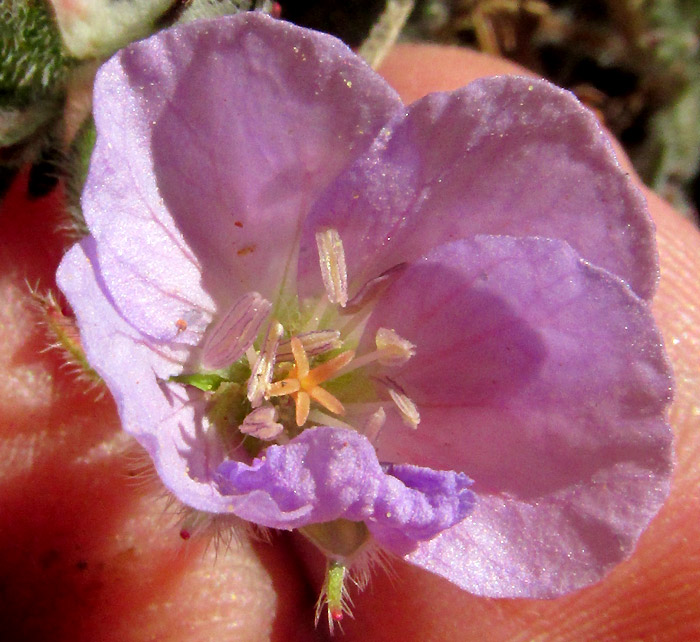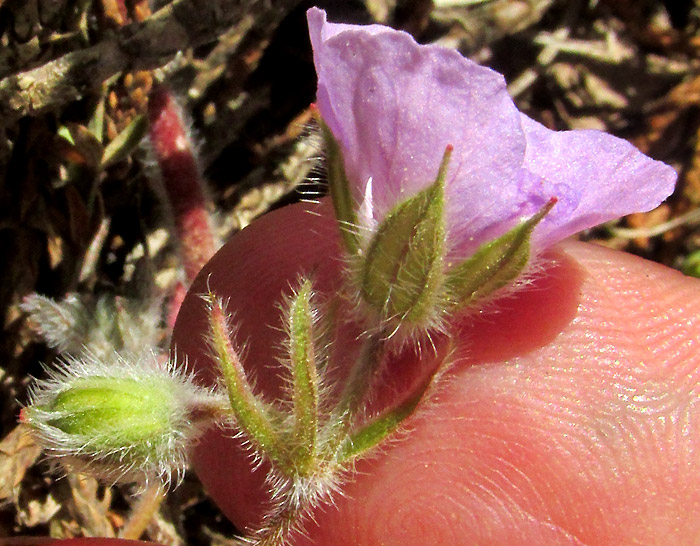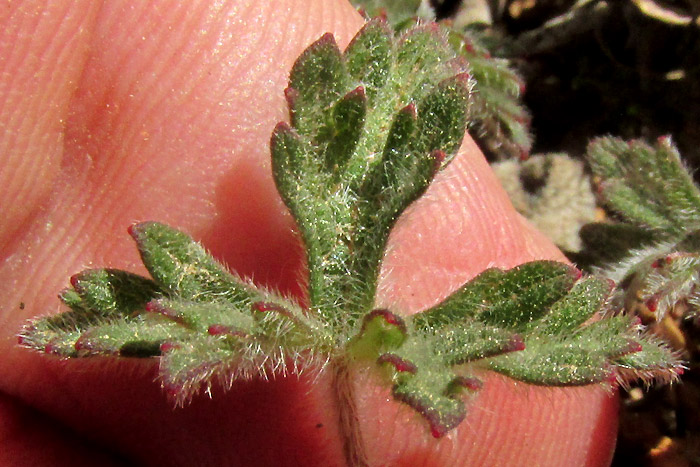Excerpts from Jim Conrad's
Naturalist Newsletter
Entry from field notes dated June 29, 2023, taken along one-lane gravel road in valley between Puerto del Zenthé and Chavarrías in mountainous area with a maze of roads too complex to say how to get there; in general it's in the mountains of east-central Querétaro state, municipality of Cadereyta de Montes, 12 straight-line kms due east of Vizarrón de Montes but much farther by twisting roads; juniper-scrub forest; limestone bedrock; elevation ~2840m (~9300 ft), Querétaro, MÉXICO, (N20.84604°, W99.60655°)
GERANIUM SCHIEDEANUM

In a semi-open spot of juniper-dominated scrubby vegetation grazed by roaming cattle, the above little "wild geranium" was the largest of several in the immediate area. It grew wedged between a juniper trunk and a rock, thus sheltered against both weather extremes and large herbivores. It looked like a geranium because the leaves are generally round in shape, but deeply divided, "palmately," like lobed fingers arising from a hand's palm. The 5-petaled flower's lavender color was right for a geranium, plus there was this:

The Geranium Family, the Geraniaceae, embraces maybe 5-7 genera, depending on your expert. In Mexico, only two genera are represented: Geranium, whose flowers produce ten stamens and whose leaves are palmately divided, and; Erodium, with five stamens, and feather-like "pinnately" divided leaves. Above we can see 7 or 8 of its stamens, thus Geranium. The blossom's central style is deeply 5-divided, starlike, which is typical for Geranium.

Above, note the flower bud at the left; two flowers are produced atop the peduncle, and that's a key field mark. At first I thought our plant was another Geranium potentillifolium, which we met this time last year on another Querétaro mountain. However, the above flower's sepals with their long, slender, needlelike tips, and three conspicuously raised, very long-haired veins, seemed different. The leaves seemed smaller and the lobes narrower, too:

And look how long-hairy the leaves' petioles were:

These plants were just beginning to flower, but a single blossom already had been pollinated, dropped its petals, and the ovary was developing into a typically Geranium long-beaked (stork-beaked), schizocarp-type fruit:

Above, you see that atop the ovary a long, reddish "beak" is weakly 5-angled at its base, reflecting the beak's partitioning into five parts, or "adherent styles." Each of the beak's five adherent styles is maturing into a slender structure which as it dries develops great internal tension, making it want to form a C-shaped curl. At the base of each tensed structure resides a one-seeded section of the ovary, a mericarp. At a certain point during the fruit's drying-out process, tension in the structure above the one-seeded mericarp causes the structure violently to snap its base outward, ripping the mericarp from the ovary, and catapulting it a distance from the mother plant. This is a feature of the whole Geranium Family and in the picture it's nice to see the catapulting device developing.
The Flora del Bajío treating our central upland region of Mexico's 12 known geranium species introduces its Geranium section by noting that Geranium taxonomy is difficult. That's because, it says, many Geranium species are highly variable, and often differ from one another by characters which are hard to see.
That being understood, in this part of Mexico, if you have a Geranium whose flowers usually appear in pairs atop their peduncles, and the flowers' lavender petals are more than 1cm long (25/64ths inch) but less than 2.5cm (7/8 inch), the plant's hairs bear no glands, and the leaf divisions are narrowly oblong, you have GERANIUM SCHIEDEANUM. Our plant bears no English name, but in Spanish sometimes is called pata de león de monte, meaning Mountain Lion's-foot.
Geranium schiedeanum is endemic just to the uplands of east-central Mexico. On the 1995 publication date of the Flora del Bajío Geranium Family treatment, the species had been documented in Querétaro state only once. The location of the collection was given as about 7km southeast of Chavarrías, Cadereyta Municipality, which apparently is the identical valley and roadside where our plants are found. The Flora described the species as rare, and vulnerable to extinction in this area, so it's gratifying to see that it's held out until now.
Despite the small size, limited distribution and apparent scarcity of Geranium schiedeanum, the online 2022 document by Blanca Estela Pérez Escandón and others entitled "Flora útil de Hidalgo" found that in two communities in Hidalgo state, on Querétaro state's eastern border, Geranium schiedeanum was one of fifteen plant species used for the treatment of cancer. The authors' experiments found partial activity against the bacterium E. coli, which causes various infections, pneumonia, meningitis and other illnesses.
The 2018 study by Nancy Vargas-Mendoza and others entitled "Effect of Extract and Ellagic Acid from Geranium schiedeanum on the Antioxidant Defense System in An Induced-Necrosis Model," concluded that "Our data confirmed the hepatoprotective {liver-protective} effect of GS {our plant} and its metabolites, like ellagic acid, support the possible use of this extract in the treatment of liver injury."